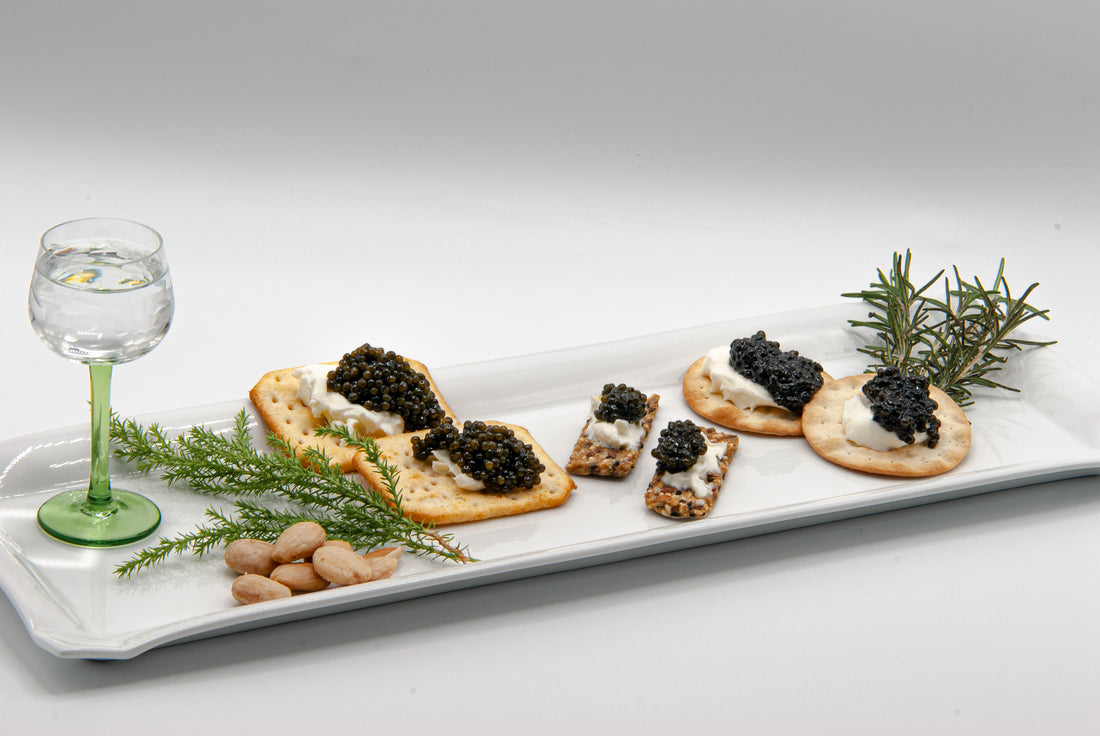
Different Caviar Grades and Curing Processes Explained
Share
What is the difference between Russian, Iranian, Beluga, Ossetra, etc?
Caviar is such a unique, luxurious delicacy, and, not unlike other rare and unique categories of delicacies, such as truffles, high-end beef, or refined liquor, there is a lot of confusion and misinformation surrounding the categories and names attached to different grades and qualities of such fine, extravagant, and high-end consumables.
Because there are no real oversight and regulations regarding the naming of categories of fish roes as “caviar,” most consumers are left to figure out what each grade truly means. Here, we hope to provide a quick primer to help you decide whether a Russian Imperial Ossetra caviar is right for you, or an Iranian Ossetra is what you’re looking for despite both having the name “Ossetra” in it.

The curing process makes a HUGE difference
You’ll typically see high end caviar labeled as “Russian” or “Iranian” grade. While this is sometimes influenced by the location where the caviar is imported from, it is more indicative of how the caviar is cured and processed to preserve a perishable delicacy. As real caviar (sturgeoun roe) originated from the Caspian Sea, Russia and Iran were the two countries bordering the Caspian, and hence had two formulas for curing the delicate eggs.
Both Russian and Iranian grade caviars are preserved using the “malossol” process, which in Russian literally translates to “little salt.” Salt is a natural preservative that has been used for thousands of years to cure a variety of perishable food, and is a natural flavor enhancer. However, too much salt can overwhelm the subtle taste of quality caviar, and the malossal process can use as little as 2.7-5% salt by content. With such low salt content, and without the use of pasteurization, the malossol process creates and preserves the unique subtle flavors of high-end caviar.
The process itself is typically passed from generation to generation as a closely guarded secret, and there are subtle differences between the “Russian” and “Iranian” processes that even we don’t know about (just kidding... 50+ years affords us some insight). But by buying Russian and Iranian grade caviar, you’re buying the best curing process. Because unlike high salt preservation which alters the taste, or pressed curing which does not retain the structure and shell of the roe, or pasteurized preservation which heats up the roe at high temperatures and sealed in glass jars, all three processes produce an altered, compromised taste to the original caviar.
In addition, just like any quality fish product (think sashimi), salt is often used to mask the product, and overwhelm the delicate taste... In other words... good caviar shouldn't be salty.
When buying caviar, first make sure the caviar originates from the sturgeon fish (Acipenseridae family), and second look for the Russian or Iranian label. Either label means you’re buying the highest quality caviar using well-guarded original method least likely to alter the original taste of the sturgeon fish’s roes.
The video above shows briefly the "malossol" process during the extraction of the sturgeon's roes and processing into caviar.
There are only a few species of sturgeons left in the world
And there are only a few places wild sturgeons are legally caught and harvested. Today, sturgeons are farmed primarily, and caviar typically comes from either the Black Sea or Caspian Sea, where the few remaining species of sturgeons remain viable. Typically when you see the grades of “Beluga,” “Ossetra,” or “Sevruga,” they refer to the species of sturgeon the caviar is harvested from.
Beluga (huso huso) is by far the rarest of the sturgeon breeds, akin to the highest grades of wagyu beef like a BMS No. 12 A5. Due to the extreme limited number of wild Beluga Sturgeon, and the specific location in the Caspian Sea being their only habitat, there are only 100 Beluga sturgeons that can be caught and harvested every year. 100% Beluga caviar is extremely rare and thus incredibly expensive.
Ossetra, or sometimes spelled Osetra, is found in both the Black Sea and Caspian Sea. While more common than Beluga sturgeon, it is still a very rare and protected species. Most Ossetra caviar are farmed, however, the sturgeon’s diet, living environment, and the WATER they’re raised in can have significant impact on the flavor profiles of their roe. Some of the highest quality Ossetra caviars use water from either the Black Sea or Caspian Sea to retain the unique flavor the most demanding caviar connoisseurs have come to demand.
Sevruga caviar comes from a more common species of sturgeon, and therefore is more affordable. The Sevruga, or Stellate sturgeon produces a much stronger flavor that some fans of caviars prefer, and while it is still a very expensive delicacy, the strong flavor that masks the unique location they’re farmed from, and the relative ease of farming compared to the other two species, makes Sevruga one of the most popular caviars in the business.
How about imperial, royal, or other grades?
Outside of Beluga, authentic caviars are separated by 2 grades within each species. Since each female sturgeon produce roes unique to each individual, the final product are separated by the uniformity of the roe, the size of the roe, and the color of the roe. If a female sturgeon produced mostly uniform sized, larger eggs, with a consistent golden hue, in the case of an Ossetra caviar this may be graded to be “Imperial” or “Royal” grade, depending on who you source the caviar from. Those that do not meet a certain standard in size, shape, color and consistency may be sold as just Ossetra. That doesn’t mean the caviar isn’t as tasty, it just means the color and presentation may not be as high quality as the higher grade.
How you chose your caviar is your own preference
All Caviar Express caviars are exclusive and of the highest quality, curated by our experts in farms around the world. But, because of how the curing process preserves the original taste, you may find a personal preference to a specific grade. For example, certain connoisseurs may prefer the strong taste of Sevruga. Or find the Russian Ossetra’s subtle nutty flavor to your liking, but prefer the golden brown huge of the Imperial grade more impressive when you serve them to your party guests. We suggest you try different grades and processes and find your favorite, even if it’s the Beluga caviar. We offer tin sizes as small as 2 oz for a quick serving for two, to as large as 1.8kg original tins, for the ultimate indulgence for you and your party guests.
